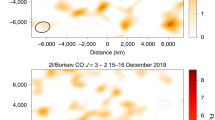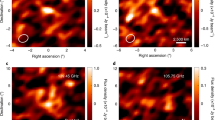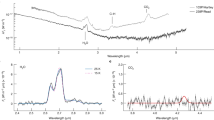Abstract
Interstellar comets offer direct samples of volatiles from distant protoplanetary disks. 2I/Borisov is the first notably active interstellar comet discovered in our Solar System1. Comets are condensed samples of the gas, ice and dust that were in a star’s protoplanetary disk during the formation of its planets, and inform our understanding on how chemical compositions and abundances vary with distance from the central star. Their orbital migration distributes volatiles2, organic material and prebiotic chemicals around their host system3. In our Solar System, hundreds of comets have been observed remotely, and a few have been studied up close by space missions4. However, knowledge of extrasolar comets has been limited to what could be gleaned from distant, unresolved observations of cometary regions around other stars, with only one detection of carbon monoxide5. Here we report that the coma of 2I/Borisov contains substantially more CO than H2O gas, with abundances of at least 173%, more than three times higher than previously measured for any comet in the inner (<2.5 au) Solar System4. Our ultraviolet Hubble Space Telescope observations of 2I/Borisov provide the first glimpse into the ice content and chemical composition of the protoplanetary disk of another star that is substantially different from our own.
This is a preview of subscription content, access via your institution
Access options
Access Nature and 54 other Nature Portfolio journals
Get Nature+, our best-value online-access subscription
$29.99 / 30 days
cancel any time
Subscribe to this journal
Receive 12 digital issues and online access to articles
$119.00 per year
only $9.92 per issue
Buy this article
- Purchase on Springer Link
- Instant access to full article PDF
Prices may be subject to local taxes which are calculated during checkout



Similar content being viewed by others
Data availability
All data are publicly available on the Mikulski Archive for Space Telescopes (https://archive.stsci.edu) under HST proposal 16049, PI D.B.
References
Guzik, P. et al. Initial characterization of interstellar comet 2I/Borisov. Nat. Astron. 4, 53–57 (2019).
Cleeves, L. I. et al. The ancient heritage of water ice in the solar system. Science 345, 1590–1593 (2014).
Rubin, M., Bekaert, D. V., Broadley, M. W., Drozdovskaya, M. N. & Wampfler, S. F. Volatile species in comet 67P/Churyumov-Gerasimenko: investigating the link from the ISM to the terrestrial planets. ACS Publ. 3, 1792–1811 (2019).
Bockelée-Morvan, D. & Biver, N. The composition of cometary ices. Phil. Trans. R. Soc. A 375, 20160252 (2017).
Matrà, L. et al. Detection of exocometary CO within the 440 Myr old Fomalhaut belt: a similar CO+CO2 ice abundance in exocomets and solar system comets. Astrophys. J. 842, 9 (2017).
The ‘Oumuamua ISSI Team. The natural history of ‘Oumuamua. Nat. Astron. 3, 594–602 (2019).
Lupu, R. E., Feldman, P. D., Weaver, H. A. & Tozzi, G.-P. The fourth positive system of carbon monoxide in the Hubble space telescope spectra of comets. Astrophys. J. 670, 1473–1484 (2007).
McKay, A. J., Cochran, A. L., Dello Russo, N. & DiSanti, M. A. Detection of a water tracer in interstellar comet 2I/Borisov. Astrophys. J. 889, L10 (2020).
Xing, Z., Bodewits, D., Noonan, J. & Bannister, M. T. Water production rates and activity of interstellar comet 2I/Borisov. Preprint at https://arxiv.org/abs/2001.04865v2 (2020).
Jehin, E. et al. COMET 2I/2019 Q4 (BORISOV). Cent. Bureau Electron. Telegraph 4719 (2020).
Eistrup, C., Walsh, C. & van Dishoeck, E. F. Cometary compositions compared with protoplanetary disk midplane chemical evolution: an emerging chemical evolution taxonomy for comets. Astron. Astrophys. 629, A84 (2019).
Ootsubo, T. et al. AKARI near-infrared spectroscopic survey for CO2 in 18 comets. Astrophys. J. 752, 15 (2012).
Meech, K. J. & Svoren, J. in Comets II (eds Festou, M. et al.) 317–335 (Univ. Arizona Press, 2004).
Cochran, A. L. & McKay, A. J. Strong CO+ and N2+ emission in Comet C/2016 R2 (Pan-STARRS). Astrophys. J. 854, L10 (2018).
Opitom, C. et al. High resolution optical spectroscopy of the N2-rich comet C/2016 R2 (PanSTARRS). Astron. Astrophys. 624, A64 (2019).
Raghuram, S. et al. Atomic carbon, nitrogen, and oxygen forbidden emission lines in the water-poor comet C/2016 R2 (Pan-STARRS). Astron. Astrophys. 635, A108 (2020).
Feaga, L. M. et al. Uncorrelated volatile behavior during the 2011 apparition of comet C/2009 P1 garradd. Astron. J. 147, 24 (2014).
Le Roy, L. et al. Inventory of the volatiles on comet 67P/Churyumov-Gerasimenko from Rosetta/ROSINA. Astron. Astrophys. 583, A1 (2015).
Bockelée-Morvan, D. et al. Evolution of CO2, CH4, and OCS abundances relative to H2O in the coma of comet 67P around perihelion from Rosetta/VIRTIS-H observations. Mon. Not. R. Astron. Soc. 462, S170–S183 (2016).
Ye, Q. et al. Pre-discovery activity of new interstellar comet 2I/Borisov beyond 5 AU. Astron. J. 159, 77 (2020).
Jewitt, D. et al. The nucleus of interstellar comet 2I/Borisov. Astrophys. J. 888, L23 (2020).
Weissman, P., Morbidelli, A., Davidsson, B. J. R. & Blum, J. Origin and evolution of cometary nuclei. Space Sci. Rev. 216, 6 (2020).
Bannister, M. T. et al. Interstellar comet 2I/Borisov as seen by MUSE: C2, NH2 and red CN detections. Preprint at https://arxiv.org/abs/2001.11605 (2020).
Levison, H. F., Duncan, M. J. & Brasser, R. Capture of the Sun’s Oort cloud from stars in its birth cluster. Science 329, 187–190 (2010).
Fitzsimmons, A. et al. Detection of CN gas in interstellar object 2I/Borisov. Astrophys. J. 885, L9 (2019).
Bailer-Jones, CorynA. L. et al. A search for the origin of the interstellar comet 2I/Borisov. Astron. Astrophys. 634, A14 (2020).
Cleeves, L. I. Multiple carbon monoxide snow lines in disks sculpted by radial drift. Astrophys. J. 816, L21 (2016).
Redwine, K. et al. New gapless COS G140L mode proposed for background-limited far-UV observations. Publ. Astron. Soc. Pac. 128, 105006 (2016).
Astropy Collaboration et al. The Astropy project: building an open-science project and status of the v2.0 core package. Astron. J. 156, 123 (2018).
Froning, C. S. et al. Multiwavelength observations of A0620-00 in quiescence. Astrophys. J. 743, 26 (2011).
Rubin, M. et al. Elemental and molecular abundances in comet 67P/Churyumov-Gerasimenko. Mon. Not. R. Astron. Soc. 489, 594–607 (2019).
Paganini, L. et al. The chemical composition of CO-rich comet C/2009 P1 (Garradd) at Rh = 2.4 and 2.0 AU before perihelion. Astrophys. J. 748, L13 (2012).
Meier, R. & A’Hearn, M. F. Atomic sulfur in cometary comae based on UV spectra of the SI Triplet near 1814 Å. Icarus 125, 164–194 (1997).
Acknowledgements
This study is based on observations with the NASA/ESA Hubble Space Telescope obtained from the Mikulski Archive for Space Telescopes at the Space Telescope Science Institute, which is operated by the Association of Universities for Research in Astronomy, Incorporated, under NASA contract number NAS5- 26555. Support for programme number GO-16049 was provided through a grant from the STScI under NASA contract number NAS5-26555. We thank A. Vick, D. Sahnow, E. Nance and C. Mannfolk at STScI for their help with scheduling the challenging HST observations. We further acknowledge the effort of many observers who supplied astrometry of 2I/Borisov to the International Astronomical Union’s Minor Planet Center to support the planning of the HST sequences, in particular E. Jehin, Q.-Z. Ye, M. Micheli, D. Tholen, T. Lister, K. Meech and S. Sheppard. Part of this research was conducted at the Jet Propulsion Laboratory, California Institute of Technology, under a contract with NASA. This research has made use of data and/or services provided by the International Astronomical Union’s Minor Planet Center.
Author information
Authors and Affiliations
Contributions
D.B. and J.W.N. performed the data reduction and analysis and wrote the paper. P.D.F. conducted the CO modelling and interpretation. J.-Y.L. led the acquisition and initial verification of the data. D.F. led the orbital characterization of 2I/Borisov required for HST pointing. K.E.M. contributed to the comparison of the elemental composition. Z.-X.X. coordinated the Swift observations and provided a comparison with H2O production rates. M.T.B., J.W.P. and W.M.H. contributed to experiment design, calibration and data interpretation. All authors discussed the results and commented on and revised the manuscript.
Corresponding author
Ethics declarations
Competing interests
The authors declare no competing interests.
Additional information
Peer review information Nature Astronomy thanks Edwin Bergin, Martin Rubin and Bin Yang for their contribution to the peer review of this work.
Publisher’s note Springer Nature remains neutral with regard to jurisdictional claims in published maps and institutional affiliations.
Extended data
Extended Data Fig. 1 Observing logs of HST observations and water production rates from simultaneous observations with Swift/UVOT (ref. 9).
T-Tp indicates the time past perihelion; Rh indicates the heliocentric distance and dRh the comet’s radial heliocentric velocity; D indicates the distance to Earth; Ncol is the derived average column density in the field of view; Q(CO) and Q(H2O) indicate the CO and water production rates corresponding to these column densities; and the radius is the radius of the field of view at the distance of the comet.
Extended Data Fig. 2 Co-added HST/COS spectra of 2I/Borisov.
Top left, Dec. 11–14, 2019 UTC; Top right, Dec. 19–22; Bottom left, Dec. 30, 2019; Bottom right, Jan. 13, 2020. Black lines indicate the smoothed HST/COS data, and red lines the best-fit CO fluorescence model.
Extended Data Fig. 3 Upper limits on sulphur in 2I/Borisov.
Synthetic atomic sulphur blended triplet emissions at 1813 Å plotted for three different column densities of sulphur. The filled region of the spectrum represents one standard deviation.
Extended Data Fig. 4 Production rates used to determine the elemental composition of volatiles in the coma of 2I/Borisov.
Water production rates were extrapolated to the dates on which the other production rates were measured using an empirical fit.
Rights and permissions
About this article
Cite this article
Bodewits, D., Noonan, J.W., Feldman, P.D. et al. The carbon monoxide-rich interstellar comet 2I/Borisov. Nat Astron 4, 867–871 (2020). https://doi.org/10.1038/s41550-020-1095-2
Received:
Accepted:
Published:
Issue Date:
DOI: https://doi.org/10.1038/s41550-020-1095-2
This article is cited by
-
Reply to: Accelerating ‘Oumuamua with H2 is challenging
Nature (2023)
-
Unraveling sulfur chemistry in interstellar carbon oxide ices
Nature Communications (2022)
-
Gaseous atomic nickel in the coma of interstellar comet 2I/Borisov
Nature (2021)
-
Iron and nickel vapours are present in most comets
Nature (2021)
-
Compact pebbles and the evolution of volatiles in the interstellar comet 2I/Borisov
Nature Astronomy (2021)



